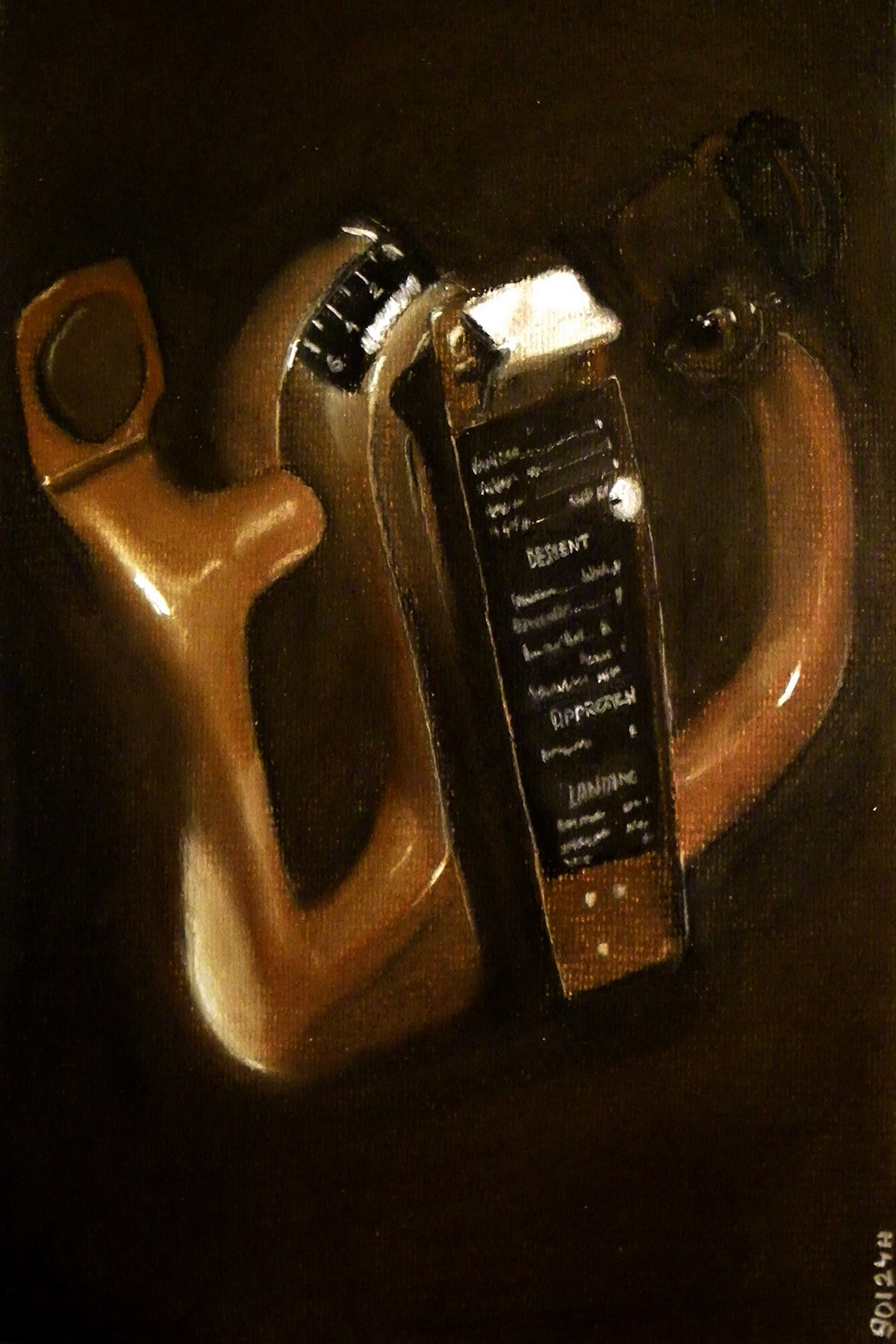Für die Einen ist es nur eine Steuersäule, für die Anderen das Tor zur Himmel“. Ganz bewusst habe ich das Steuerhorn isoliert von den anderen Steuerelementen wie Schub-, Klappen- und Fahrwerkshebel dargestellt und es quasi ins Rampenlicht gerückt. Denn es ist die ursprünglichste Mensch-Maschine-Schnittstelle der Fliegerei. Mit ihm gelingt es uns Piloten, ein bis zu mehreren hundert Tonnen schweres Monstrum sicher durch die Lüfte zu bewegen. Wie ein erfahrener Reiter mit den Zügeln den Kontakt zu seinem Pferd hält und es mit kleinsten Bewegungen der Hand durch Parcours und Gelände führt, so lenken wir Piloten unser Flugzeug durch die Luft, um Wolken und Hindernisse herum, sicher auf den gewünschten Kurs. Ich spüre am Steuerhorn, ob das Flugzeug zu langsam wird und mehr Schub braucht oder ob eine Aufwindböe es erfasst und vom Gleitpfad wegziehen will. Manchmal reichen kleine Korrekturen, mit den Fingerspitzen quasi, und manchmal muss man kräftig gegen halten, wenn ein plötzlicher Seitenwind den Flügel hochreißt.
Gewiss gibt es Unterschiede zwischen den verschiedenen Arten von Steuerknüppeln und manch erbitterter Disput ist daran entbrannt welche Art besser sei, die konventionelle, wie hier auf dem Bild, oder der sogenannte Sidestick, der die Steuersignale nur noch digital übermittelt. Eines haben aber beide gemeinsam: ohne eine gewisse Begabung bei der Auge-Hand-Koordination und ohne eine profunde Ausbildung und Übung bleiben beide ein wertloses Instrument. Ebenso wie Geige und Bogen ohne die erfahrene Hand des Musikers keinen Ton zustande bringen.
Für mich ist das einer der schönsten Momente des Fliegens: Bei gleißendem Sonnenlicht umgeben von weißen Cumulus-Wolken in einem azurblauen Himmel mit einer kleinen Bewegung am Steuerhorn das Flugzeug in die Kurve zu egen und auf einen neuen Kurs zu bringen. Wie gesagt: „Für die Einen ist es nur eine Steuersäule …“.
There is a famous chocolate bar commercial in Germany and its catch phrase is: „For some people it’s just a chocolate bar. For others it’s the world’s biggest praline“.
There is a similar feeling about this picture, too. For some people, it’s just a control column or yoke, for others, it’s the key to the sky. I purposefully isolated the yoke from the other cockpit control elements like thrust, flaps and gear lever and quite literally put it in the spotlight, for it represents the ultimate man-machine-interface in aviation. With it, we pilots succeed in navigating a monster weighing several hundred tons through the air. Just as an experienced rider uses the reins to stay in contact with his or her horse and guide it over the paddock or open country, we pilots steer our airplanes through the sky, around clouds and obstacles and onto a safe flight path. I can feel the subtle pressure in the control column when the airplane loses speed and needs more thrust or when an updraft wants to pull it away from the correct glide path. At times, tiny corrections with your fingertips are enough while at other times a stronger grip is needed to control a sudden crosswind that lifts the wing.
Naturally, there are variations in concept designs for control devices and there is an intense debate about which concept is the ‘better’ way to control an airplane: the conventional style, as shown in this picture, or the more ’modern style’, the so-called ’sidestick’ controller that transmits the pilot’s input via digital channels only. Both options require a talent for hand-eye coordination and solid training. Without this, both controls remain a worthless tool, just as a violin and bow will not produce a single note without the experienced hand of a well trained musician.
For me this remains one of the most beautiful moments of flying: being in a bright blue sky, surrounded by white puffy cumulus clouds and banking the plane with a tiny motion of the yoke and gently turning it towards a new course. As I wrote in the beginning: „For some people it’s just a control column…“

